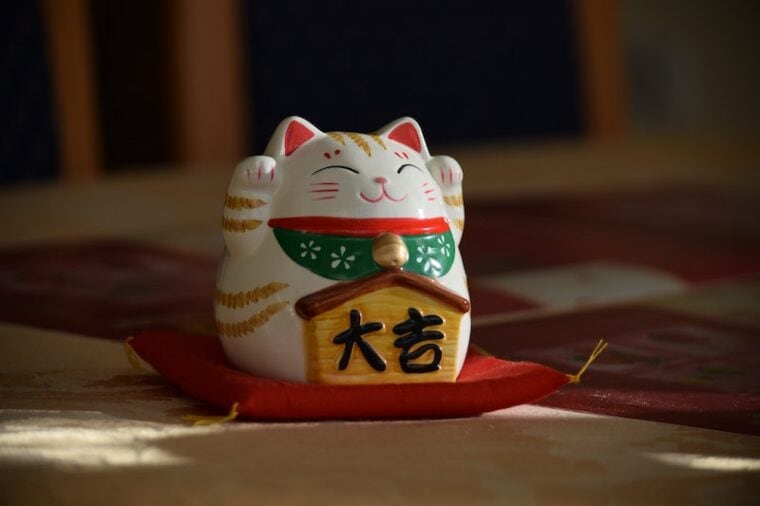
Maneki-Neko is a well-known figure in Asian culture. Known as the Chinese or Japanese Waving Cat, the lucky cat, or the welcoming cat, Maneki-Neko is recognized visually, though many are unfamiliar with its unique history.
The kitschy figure is seen all over the world, but as a good-luck charm, it dates back to the 17th century.
What Is Maneki-Neko?
Though often associated with China, Maneki-Neko is actually a Japanese figure—the name literally means “beckoning cat”1. The figurine is a Japanese Bobtail cat with a raised paw, pointy red ears, and accessories like coins (typically the koban coin from Japan’s Edo period) and other symbols of fortune to bring luck and prosperity to its owners. Some versions even have motorized arms that allow it to “wave” all day.

The cat’s arm can be on the left or right, depending on the needs of the owner. If the left arm is raised, the cat is inviting customers in. If the right paw is raised, it’s said to bring wealth and money.
The figurine may be in different colors, depending on what type of fortune the owner is trying to attract. These colors include:
| White: | Happiness and purity |
| Black: | Safety from evil spirits |
| Red: | Protection from illness |
| Gold: | Wealth |
| Pink: | Love, romance |
| Blue: | Success in academic endeavors |
| Green: | Protection for family |
Maneki-Neko is usually displayed at the entrances of businesses like bars, restaurants, and laundromats to beckon patrons inside.
The Origin of Maneki-Neko
Maneki-Neko is a popular figure in Chinatowns, so many mistakenly believe it’s a Chinese figure. It’s actually believed to have originated during the Edo period in Japan; however, its exact origins are unknown.
One of the earliest records of Maneki-Neko is in Hiroshige’s ukiyo-e woodblock print from Flourishing Business in Balladtown in 1852, which shows the Marushime-Neko, a variation of Maneki-Neko, sold at the Senso temple.
Maneki-Neko also appeared in a newspaper article in 1876 during the Meiji period. These figurines were wearing kimonos and were distributed at a shrine in Osaka. The first evidence that Maneki-Neko became a commercial good-luck charm came around 1902.

Maneki-Neko as a Lucky Charm
In Western culture, domestic cats are primarily kept as pets. In Japan, they are believed to have protective power and act as a symbol of good fortune, like Maneki-Neko.
Based on folklore, Maneki-Neko is based on a real cat. A 17th-century monk lived in the Gōtoku-ji temple in Setagaya with his pet Japanese Bobtail. One day, a lord samurai, Ii Naotoka of Hikone, was in the area to hunt when a storm erupted.
Taking shelter under a tree outside the temple, the lord noticed the monk’s cat had one paw raised like he was waving him into the temple. Grateful for saving his life, the lord became a patron of the temple and helped to repair it.
After the cat died, it was commemorated in a statue, and the location is still regarded as a sacred site. This is also the reason that many believe the beckoning cat to be a symbol of good fortune.
Cultural Legacy
Maneki-Neko is an enduring figure in Asian cultures. You can find figurines all over shops and businesses in Japan, China, and all over the world. Okayama also showcases a collection of 700 beckoning cat statues in the Manekineko Museum of Art.
Each year in September, beckoning cats are celebrated in the Manekineko Festival in major cities in Japan. During this event, people attend themed events and paint themselves to look like the lucky cat.
Naturally, the Gōtoku-ji temple—where the legend originated—is still home to hundreds of figurines.
The US is home to a cultural site of its own. Ohio’s Lucky Cat Museum in Cincinnati has over 2,000 variations of the iconic Maneki-Neko cat figurine on display.

Why Does Maneki-Neko Wave?
Maneki-Neko is sometimes called the Chinese or Japanese Waving Cat, though it’s not actually waving. In Japanese culture, unlike Western cultures, holding your hand with the palm forward and fingers pointing down is the way to beckon someone over to you. This is why Maneki-Neko’s hand faces down.
Summary
Though it originated in Japan, Maneki-Neko is an iconic figure in Asian cultures and appears all over the world. The figurine endured for centuries as a symbol of financial wealth, love, protection, health, and good fortune, making it a strong icon for people of all cultures.
- Related Read: Cats in Chinese Culture & History: Where Do They Fit In?
Featured Image Credit: Darko Majcenovic, Pexels







